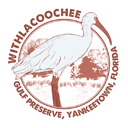The Withlacoochee Gulf Preserve underwent a controlled (prescribed) burn on April 20, 2016. The Yankeetown management plan for the Preserve includes the use of periodic controlled burns. Frequent low-intensity fires are natural phenomena. Fire suppression by man is not. The health of many ecosystems depends on fire. Low-intensity fire promotes new growth and prevents the build up of fuel that could cause a devastating, all consuming, wildfire.
The town of Yankeetown, the WGP Board, and the Friends of the WGP want to thank the Florida Forest Service for a job well done. The result of this successful burn will be a healthier Preserve and a safer Yankeetown community. If you would like to learn more about the burn please watch this video.



 Gopher tortoises (Gopherus polyphemus) are long-lived reptiles native to the southeastern United States. They occupy upland habitat throughout Florida including forests and pastures. Gopher tortoises are herbivore scavengers and consume a variety of plants, including grasses and terrestrial legumes. (Photo by FWC Research)
Gopher tortoises (Gopherus polyphemus) are long-lived reptiles native to the southeastern United States. They occupy upland habitat throughout Florida including forests and pastures. Gopher tortoises are herbivore scavengers and consume a variety of plants, including grasses and terrestrial legumes. (Photo by FWC Research)